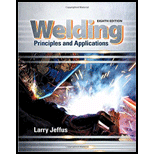
Bundle: Welding: Principles and Applications, 8th + MindTap Welding, 4 terms (24 months) Printed Access Card
8th Edition
ISBN: 9781337219426
Author: Larry Jeffus
Publisher: Cengage Learning
expand_more
expand_more
format_list_bulleted
Concept explainers
Textbook Question
Chapter 20, Problem 32R
List examples of overhead costs that a welding shop might have.
Expert Solution & Answer
Trending nowThis is a popular solution!

Students have asked these similar questions
Solve this problem and show all of the work
draw the pneumatic circuit to operate a double-acting cylinder with:
1. Extension: Any of two manual conditions plus cylinder fully retracted,
→ Extension has both meter-in and meter-out,
2. Retraction: one manual conditions plus cylinder fully extended,
→ Retraction is very fast using quick exhaust valve.
Correct answer is written below. Detailed and complete solution with fbd only. I will upvote, thank you. Expert solution pls
Chapter 20 Solutions
Bundle: Welding: Principles and Applications, 8th + MindTap Welding, 4 terms (24 months) Printed Access Card
Ch. 20 - What are two ways math is most commonly used in...Ch. 20 - What is the two-letter abbreviation for the metric...Ch. 20 - List factors that affect the cost of producing...Ch. 20 - List three examples of whole numbers.Ch. 20 - List three examples of decimal fractions.Ch. 20 - List three examples of a mixed unit.Ch. 20 - List three examples of fractions.Ch. 20 - Add the following angles: a. 3050+205 b. 2525+6245Ch. 20 - Subtract the following angles: a. 45481020 b....Ch. 20 - Using the Pythagorean theorem, find c if a=6 and...
Ch. 20 - Sketch a right triangle, equilateral triangle, and...Ch. 20 - Find the area of the following: a. Square that is...Ch. 20 - Find the volume of the following: a. 5 cube b. 10...Ch. 20 - What would the labor cost be if 20 hours were...Ch. 20 - What is the first step in the sequence of...Ch. 20 - If you need two pieces of pipe—one must be 15 ft...Ch. 20 - How many total feet of metal stock would you need...Ch. 20 - How many total feet of metal stock would you need...Ch. 20 - How many feet of scrap pipe will you have left...Ch. 20 - How much scrap pipe will you have once you cut out...Ch. 20 - When the denominators of two fractions to be added...Ch. 20 - How thick will the finished part be if two pieces...Ch. 20 - How much metal is left if 1/8 in. is ground off a...Ch. 20 - What is a dimensioning tolerance?Ch. 20 - What is the minimum and maximum length a part can...Ch. 20 - Give examples of welding applications where angles...Ch. 20 - Write the Pythagorean Theorem formula for a right...Ch. 20 - What is the name of a triangle where all three...Ch. 20 - Why is it important to know the perimeter...Ch. 20 - In what welding applications might you need to...Ch. 20 - List examples of fixed and variable costs that...Ch. 20 - List examples of overhead costs that a welding...Ch. 20 - When estimating weld cost, what weld joint design...Ch. 20 - When a weld is oversized, what joint failure...Ch. 20 - How does the bevel angle in a groove weld affect...Ch. 20 - What is the cross-sectional area of a V-groove...Ch. 20 - What is the cross-sectional area of a fillet weld...Ch. 20 - What two amounts must be multiplied to determine...Ch. 20 - How many pounds of steel electrode are required to...Ch. 20 - Not every pound of electrode filler metal used is...Ch. 20 - What does it mean if an electrode has a 50...Ch. 20 - What is the meaning of the term deposition rate?Ch. 20 - What factor is not included in the deposition...Ch. 20 - Why do flux cored wires have a higher deposition...Ch. 20 - If a welding project has a 45% operating factor,...
Knowledge Booster
Learn more about
Need a deep-dive on the concept behind this application? Look no further. Learn more about this topic, mechanical-engineering and related others by exploring similar questions and additional content below.Similar questions
- Correct answer is written below. Detailed and complete solution with fbd only. I will upvote, thank you.arrow_forwardCorrect answer is written below. Detailed and complete solution with fbd only. I will upvote, thank you.arrow_forwardCorrect answer is written below. Detailed and complete solution only with fbd. I will upvote, thank you.arrow_forward
- Correct answer is written below. Detailed and complete solution only. I will upvote, thank you.arrow_forwardCorrect answer is written below. Detailed and complete solution with fbd only. I will upvote, thank you.arrow_forwardCorrect answer is written below. Detailed and complete solution only. I will upvote, thank you.arrow_forward
- Correct answer is written below. Detailed and complete solution with fbd only. I will upvote, thank you.arrow_forwardCorrect answer is written below. Detailed and complete solution only. I will upvote, thank you.arrow_forwardCorrect answer is written below. Detailed and complete solution only. I will upvote, thank you.arrow_forward
- Correct answer is written below. Detailed and complete solution only. I will upvote, thank you.arrow_forwardCorrect answer is written below. Detailed and complete solution with fbd only. I will upvote, thank you. Prefferably handwritten solution pleasearrow_forwardCorrect answer is written below. Detailed and complete solution with fbd only. I will upvote, thank you. Prefferably handwritten solution pleasearrow_forward
arrow_back_ios
SEE MORE QUESTIONS
arrow_forward_ios
Recommended textbooks for you
 Welding: Principles and Applications (MindTap Cou...Mechanical EngineeringISBN:9781305494695Author:Larry JeffusPublisher:Cengage Learning
Welding: Principles and Applications (MindTap Cou...Mechanical EngineeringISBN:9781305494695Author:Larry JeffusPublisher:Cengage Learning

Welding: Principles and Applications (MindTap Cou...
Mechanical Engineering
ISBN:9781305494695
Author:Larry Jeffus
Publisher:Cengage Learning
Metal Joining Process-Welding, Brazing and Soldering; Author: Toc H Kochi;https://www.youtube.com/watch?v=PPT5_fDSzGY;License: Standard YouTube License, CC-BY